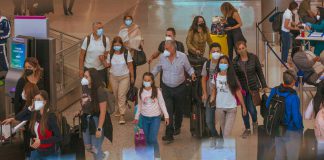MAY 6, 2021
The contrast could hardly be sharper.
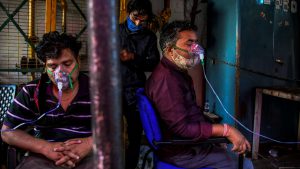
Receiving oxygen treatments for Covid-19 last month in Delhi. – Atul Loke / NY Times
In much of the developed world, vaccine orders are soaring into the billions of doses, Covid-19 cases are easing, economies are poised to roar to life and people are busy lining up summer vacations. In many less developed nations, though, the virus is raging on, sometimes out of control, while vaccinations are happening far too slowly to protect even the most vulnerable.

A live music concert in Liverpool, England, on Sunday. While poorer nations grapple with a record surge in the virus, people in richer nations are celebrating their liberation from the pandemic. – Paul Ellis/Agence France-Presse — Getty Images
That split screen — clubs and restaurants reopening in the United States and Europe while people gasp for oxygen in India — was never supposed to be so stark. Some 192 countries signed up last year for Covax, a vaccine-sharing partnership, and the Gates Foundation poured $300 million into an Indian factory to make doses for the world’s poor. The European Union’s top executive told a global summit last June: “Vaccination is a universal human right.”
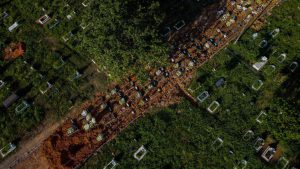
Graves of coronavirus victims at a cemetery in Manaus last month. In Brazil, thousands are dying daily. – Michael Dantas/Agence France-Presse — Getty Images
But the virus is spreading more rapidly than ever, driven largely by gains in South America and India, and the campaign to vaccinate the world is floundering.
India, an important source of vaccines in normal times, has halted exports as it fights a record surge in the virus and an expanding humanitarian crisis. That has delayed critical shipments, with India making the majority of Covax supplies.
In Brazil, where thousands are dying daily, officials have received only a 10th of the AstraZeneca doses they were promised by midyear.
And in countries as varied as Ghana and Bangladesh, which blew through their initial vaccine supplies, the lucky few who received a first shot have been unsure of when they will receive another.
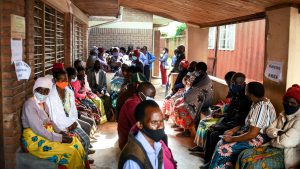
A vaccination center in Malawi, which has inoculated only 2 percent of its population. – Thoko Chikondi/AP
“It’s a moral issue,” said Boston Zimba, a doctor and vaccine expert in Malawi, which has vaccinated only 2 percent of its people. “This is something rich countries should be thinking about. It’s their conscience. It’s how they define themselves.”
The problems go well beyond the availability of vaccines to deep-seated logistical problems and vaccine hesitancy, an inheritance with roots in the colonial and imperial eras.
CARE, a global nonprofit, estimated that for every $1 spent on vaccine doses, another $5 was needed to guarantee that they made it from airport runways into people’s arms. In the absence of enough funding for chronically underpaid health workers and vaccination training, many of the few doses that have been delivered are sitting in warehouses, with expiration dates rapidly approaching.
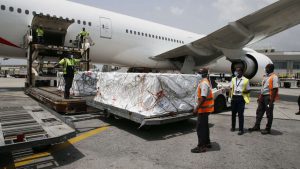
Receiving boxes of the AstraZeneca vaccine in Ivory Coast, which has administered only 155,000 of the 504,000 doses it has received. – Legnan Koula/EPA, via Shutterstock
The stuttering global rollout is having calamitous consequences. Unvaccinated nations are being walloped by the virus. New variants could emerge in reservoirs of untamed infections, prolonging the pandemic for rich and poor nations alike. The global economy stands to suffer trillions of dollars in losses.
Yet, for all the determination of global leaders to right past wrongs — most recently, a scarcity of swine flu vaccines in poorer nations during that 2009 pandemic — the difficulties facing the current inoculation campaign are steep.
When the pandemic exploded into view last year, Covax was short on funds, making it impossible to compete with richer nations in locking down contracts for vaccines. More recently, the United States, the European Union and India have barred at least some vaccine-related exports, leaving regions that do not make their own doses dependent on those that do.
Lately, Western nations have begun promising vaccines to the developing world — 60 million AstraZeneca doses from the United States, one million AstraZeneca doses from Sweden. But these “donations” are a drop in the bucket, and have in some cases been haphazardly planned, leaving countries too little time to administer the doses.
Even as richer nations inoculate their own citizens, they may start saving vaccine-making capacity for booster shots to deploy against new variants, another blow to countries bereft of manufacturing bases.
Vaccine makers are prospering off sales to the world’s rich. Pfizer brought in $3.5 billion from its vaccine in the first three months of 2021, while it has promised Covax less than 2 percent of this year’s doses. Moderna, expecting $18 billion in vaccine sales in 2021, agreed only this week to supply Covax, despite taking an early investment from a leading Covax foundation last January.
But nationalism and corporate profits are only part of the story. There is also the sheer difficulty of making so many doses.
Pressure has been building on the Biden administration to suspend intellectual property rights on vaccines to encourage wider manufacturing. But given the production difficulties, that step could take years to yield results, experts say.
However much it costs, and however long it takes, Western nations should also pressure vaccine makers to partner with global manufacturing sites, analysts said. Ramping up production in that way can be bumpy, but surveys last year suggested there was untapped capacity.
And local manufacturing can temper fears of foreign-made vaccines. “The end game is to bring vaccines that are built and manufactured in Africa,” said President Félix Tshisekedi of the Democratic Republic of Congo, “because it will create trust and confidence in people because they know it’s a vaccine made by us and for us.”
For Covax, a heavy reliance on shipments from India has been costly. In January, it forecast having 235 million doses by April and 325 million by May on its way to two billion doses this year, enough to vaccinate 20 percent of people in recipient countries, according to planning documents saved by Zain Rizvi, a medicines access expert at Public Citizen, an advocacy group.
But by March, that forecast had been slashed by roughly a third. And as of Tuesday, Covax had shipped 54 million doses, less than a quarter of its earlier April target. Gavi, the Vaccine Alliance, a public-private health partnership coleading Covax, said it was prioritizing second dose deliveries and urging richer nations to share vaccines.
While poorer nations scramble for supplies, many of them are also struggling to use what few doses they have. Those operational failures — a rerun of what wealthy nations went through months earlier — have left stockpiles of vaccines inching toward expiration dates in countries that cannot afford to waste any doses.
The problem is particularly acute in Africa, where roughly two dozen countries have used less than half of their vaccines, according to figures from CARE.
The Democratic Republic of Congo sat on 1.7 million AstraZeneca doses from Covax for nearly two months because of safety concerns in Europe. Since vaccinations began in April, only 1,888 people have been inoculated, forcing the country to send most of its supply to nearby nations to save it from expiring.
Ivory Coast received 504,000 AstraZeneca doses from Covax in late February, yet to date has administered 155,000. At vaccination sites in Abidjan, the country’s largest city, waiting chairs sit empty and health workers play on their phones to pass the time.
Western warnings about very rare vaccine side effects have spread on social media, said Dr. Arsène Adepo, making people wonder why a shot that much of Europe had temporarily rejected was fit for Ivorians. Those worries compounded fears that Africans were being used as “guinea pigs” and that the shots would reduce fertility.
Yet vaccine confidence collapsed in part because the government did so little to build faith in the first place: Ivory Coast health officials said that a public awareness campaign would begin only this week, more than two months after the first doses arrived. Local officials did not even decide how to transport vaccines across Abidjan until they had them in hand, health workers said.
Many countries, prepared for the sort of childhood vaccination campaigns they carry out regularly, were startled to find that they could not rely on people simply to show up for a coronavirus vaccine.
“A lot of vaccine hesitancy issues could be addressed, though not all of them overcome, with timely operational funding in place,” said Benjamin Schreiber, the coordinator for Covid-19 vaccines at UNICEF, which is leading Covax delivery efforts.
Amid a race to fund vaccine purchases, though, money for getting them into people’s arms has been overlooked. Of the 92 poorer nations being supplied by Covax, eight have cut their health budgets because of virus-related economic losses, and several others are struggling to fund their health systems in part because they do not qualify for grants or more generous loans, Mr. Schreiber said.
The World Bank has promised $12 billion for vaccine rollouts, but has so far approved $2 billion in projects. In mid-March, the bank found that less than a third of low- and middle-income nations reported having plans to train enough vaccinators or campaigns in place to fight vaccine hesitancy, said Mamta Murthi, the bank’s vice president for human development.
Many countries’ needs are even simpler. Some cannot pay to print immunization cards. Malawi, which is planning to destroy 16,000 doses that arrived shortly before they expired, has struggled to cover lunch allowances for health workers traveling from one facility to another to give vaccines.
The outlook is uncertain. More doses will breed more vaccine confidence, said Freddy Nkosi, the country director in the Democratic Republic of Congo for VillageReach, a health nonprofit. But if India’s outbreak keeps surging, the chief executive of the Serum Institute of India said recently, “We are going to have to keep supplying to India, and not anywhere else.”
Ruth Bechtel, VillageReach’s country director in Mozambique, said that expanding the vaccination drive as more doses arrived would create new logistical hurdles. The country has administered roughly a quarter of the doses it has received. Supply chain managers need to be able to monitor the stock at different vaccination sites, Ms. Bechtel said, and more health workers need to learn how to give the shots.
“As more vaccines come in, and a larger population begins to be vaccinated, there will be a need to have more people that are trained,” she said. “That has not happened yet.”
Courtesy/Source: NY Times

































































































